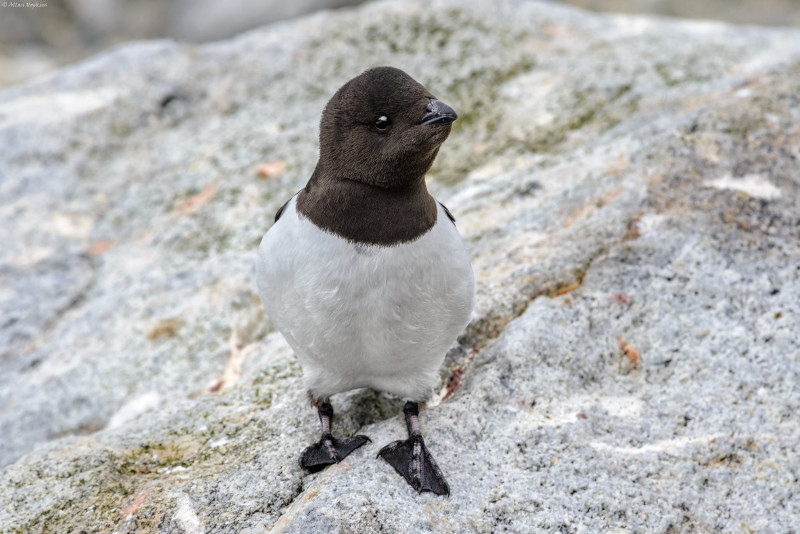
Little Auk Facts
- The most typically employed common name for this small yet beautiful work of Nature and evolution is that of the Little Auk. The small avian does several other alternate titles, though. These include the terms dovekie and sea dove, among others.
- Inside of scientific circles, however, it’s perhaps better known by its technical title. Fortunately for the layperson, that’s also a simple term to pronounce. Indeed, it’s an extremely simple one. That’s because this marvel of Nature holds the tag Alle alle.
- The amazing creature received that short designation due to the efforts of Carl Linaeus himself. The eminent Swedish biologist accomplished the first recognition of it as a separate and distinct species. He managed that scientifically noteworthy feat in 1758.
- Thankfully, the Little Auk appears to be maintaining a population base that’s both stable and sufficient. That pleasant state also seems to hold true across its territorial range. The IUCN therefore currently shows it as Least Concern on its Red List.
- The biological wonder nonetheless still faces the same potential threats to its continued existence as all species on earth today. Like them, most of those perils stem from the actions of mankind. They include the dangers of habitat loss and climate change.
Related Articles
Little Auk Physical Description
The remarkable Little Auk typically captivates those who view it. Unlike many species, though, it doesn’t do so due to impressive wingspans. That’s due to the fact that the animal truly merits its name. Nature, however, packed many intriguing traits into a small package.
In terms of those physical qualites, though, it does deviate from a pattern common to many animals. That’s in the fact that it displays no noticeable degree of the physiological characteristic of sexual dimorphism. It’s therefore difficult to distinguish the sexes visually.
Individual body length ranges from approximately 7.5 – 9.5 in (19 – 24 cm). While exceptional specimens do naturally occur, they rarely exceed this to any significant degree. By comparison, this measurement makes them about half the size of the Atlantic puffin.
The wingspan of the lovely animal also varies accordingly. On average, however, this aspect ranges from 13 – 15 in (34 – 38 cm). Like most birds, it maintains a slight body mass. In its case, the facinating bird maintains a mean weight between 4.7 – 7.2 oz (0.13 – 0.2 kg).
It’s the coloring of the Little Auk that garners the most interest, though. In breeding season, it shows black plumage on its upperparts with a white belly. The wings show dark with white patches, and a white spot behind the eye. At other times, the throat becomes darker.
The impressive animal also shows a distinctively short, stubby, black bill, that’s somewhat upturned at its end. The feet are webbed, and both they and the short legs also show a deep black shade. Even the eyes of this natural marvel present a dark color to the world.
- Kingdom: Animalia
- Phylum: Chordata
- Class: Aves
- Order: Charadriiformes
- Family: Alcidae
- Genus: Alle
- Species: A. alle
Little Auk Distribution, Habitat, and Ecology
The amazing Little Auk evolved as native to a surprisingly broad expanse of the surface of the earth. The exact location of that zone of habitation won’t surprise anyone, however. That’s because this diminutive marvel developed as endemic to a circumpolar range.
That means it’s distributed throughout the Arctic regions of the world. In the North Atlantic, this includes such regions as Iceland, Greenland, northern Russia. In the North Pacific, meanwhile, it often appears along northeastern Russia, and in parts of the Bering Sea.
This captivating creature displays decidedly clear and strong preferences regarding its choices for its habitat. The very nature of these is often defined by its region of the world, in fact. It’s highly adapted to living in areas with abundant quantities of sea ice.
When not actively flying, or hunting for food, it rarely strays far from the water. At rest, it typically seeks shelter in rocky crevices or burrows. These in turn, as indicated, usually exist near the shore. In winter, however, they move southward, but seek similar sites.
Much like its flightless avian cousins the penguins, the Little Auk hunts its food underwater. Despite its fully functioning wings, it’s an excellent diver, often reaching relatively impressive depths. The marvelous animal primarily feed on small fish and various crustaceans.
During breeding season, the species lives in colonies numbering in the thousands, sometimes even in the millions. These occur near sites rich in food. After mating, females generally lay a single egg only. Both parents care for the egg, taking turns incubating it.
Species Sharing Its Range
Arctic Fox
Polar Bear
Check out our other articles on 5 Fabulous Flora of Germany, Cape Porcupine, Lake Itasca, Sicilian Fir, East African Lowland Honey Bee, Southern Stingray, Weka, Alligator Snapping Turtle
